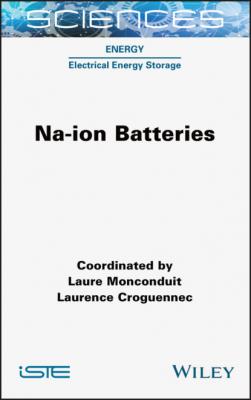ТОП просматриваемых книг сайта:
Na-ion Batteries. Laure Monconduit
Читать онлайн.Название Na-ion Batteries
Год выпуска 0
isbn 9781119818045
Автор произведения Laure Monconduit
Жанр Физика
Издательство John Wiley & Sons Limited
Table of Contents
1 Cover
4 Introduction I.1. Why Na-ion batteries? I.2. From the electrodes to the electrolyte for NIBs I.3. Future commercialization of NIBs I.4. References
5 1 Layered NaMO2 for the Positive Electrode 1.1. Research history of layered transition metal oxides as electrode materials for Na-ion batteries until 2009 1.2. Crystal structures of layered materials 1.3. O3-type layered materials 1.4. P2-type layered materials 1.5. Summary and prospects 1.6. Acknowledgments 1.7. References
6 2 Polyanionic-Type Compounds as Positive Electrodes for Na-ion batteries 2.1. Introduction 2.2. NASICON structures as model frameworks in sodium-ion battery applications 2.3. Na3V2(PO4)2F3 used as a model framework in sodium-ion battery applications 2.4. Conclusion and perspectives 2.5. References
7 3 Hard Carbon for Na-ion Batteries: From Synthesis to Performance and Storage Mechanism 3.1. Introduction 3.2. What is a hard carbon? 3.3. Hard carbon synthesis and microstructure 3.4. Hard carbon characteristics 3.5. Electrochemical performance 3.6. Conclusion 3.7. References
8 4 Non-Carbonaceous Negative Electrodes in Sodium Batteries 4.1. Introduction 4.2. Insertion materials 4.3. Negative electrode materials based on electrochemical alloying with sodium 4.4. Negative electrode materials based on conversion reactions 4.5. Conclusion 4.6. References
9 5 Electrolytes for Sodium Batteries 5.1. Introduction 5.2. Liquid and solid electrolytes for sodium batteries 5.3. Properties of IL-based electrolytes for Na batteries 5.4. Modeling IL-based electrolytes 5.5. Conclusion and future perspectives 5.6. Abbreviations 5.7. References
10 6 Solid Electrolyte Interphase in Na-ion batteries 6.1. Introduction 6.2. Physical properties of the Na-ion SEI 6.3. Comparisons of SEI in sodium- and lithium-based electrolytes 6.4. Conclusion 6.5. References
11 7 Batteries Containing Prussian Blue Analogue Electrodes 7.1. Introduction 7.2. Electrochemistry of PBAs 7.3. Prussian blue batteries 7.4. Conclusion and future outlook 7.5. References
12 8 The Design, Performance and Commercialization of Faradion’s Non-aqueous Na-ion Battery Technology 8.1. Introduction 8.2. Experimental 8.3. Cell performance 8.4. Safety and zero energy storage and transportation 8.5. Scale-up and prototyping 8.6. Demonstrators: stacks and packs 8.7. Business and IP strategy 8.8. Cost analysis 8.9. Future developments Скачать книгу

